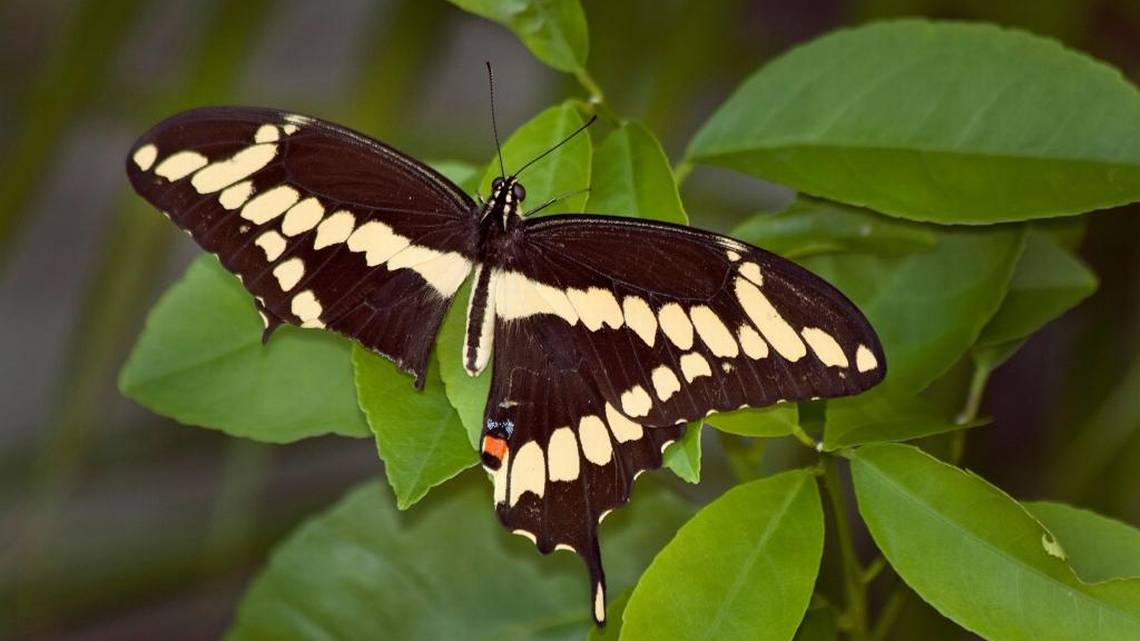He found the mysterious lemon growing on doorsteps in China. Now it’s a US favorite.

BY KENNETH SETZER
Fairchild Tropical Botanic Garden
As published in the Miami Herald, November 30, 2017 07:30 AM
More than a century ago, a Dutch plant explorer faced death to bring us the Meyer lemon. We know what happened after that — it became extremely popular in the United States both for eating and gardening — but not before; the lemon’s origins are a mystery.

A damaged adult giant swallowtail on Meyer lemon, its citrus host plant. KENNETH SETZER/Fairchild Tropical Botanic Garden
We know more about the explorer, Frank Meyer, who lived an enthralling life. Born in Amsterdam, Meyer lived the definition of “wanderlust,” walking to Italy to visit orange groves, taking months to wander Europe, and eventually buying a one-way ticket to the United States.
An experienced horticulturist and avocational botanist, he soon found employment with the U.S. Department of Agriculture, where David Fairchild recognized his love for travel and knowledge of plants as invaluable. Fairchild sought a plantsman to explore the great biodiversity of China for plants that could help American farmers with rootstock and crops tolerant of cold and pests.
In an odyssey that couldn’t be replicated today, Meyer shipped out to Beijing in 1905 and wandered for months, also exploring Mongolia and what is today North Korea. Walking 20 to 35 miles a day, Meyer’s group ultimately reached Siberia, where he sought cold- and drought-tolerant vegetables and trees that could be of use particularly in America’s northwestern prairie states.
Threatened at gunpoint more than once, Meyer was not easily discouraged by danger or discomfort, and his determination was soon rewarded when he found the legendary “pound peach” (Prunus persica) of Shantung (Shandong), which sometimes weighs more than a pound.
In Beijing he discovered people growing an attractive little “dooryard” plant with glossy green leaves and dangling yellow fruit. A rather small citrus tree at up to 10 feet, it was kept in pots as a cheerful greeting at front doors.

Meyer lemon trees are easily kept a few feet tall. KENNETH SETZER/Fairchild Tropical Botanic Garden
Meyer sent the plant back to the United States, and by 1908 it was being grown in experimental USDA plots. Eventually it was introduced to cultivation and named the Meyer lemon.
The fruit is generally rounder than a supermarket lemon (Citrus limon) without the tapered nipple, and thinner skinned. The flesh is sometimes a deeper yellow, and is less acidic and sweeter than regular lemons. It’s thought to be a hybrid of lemon and mandarin orange (Citrus reticulata) but that’s not a certainty as its history before Meyer found it is unknown.
If you now acquire a Meyer lemon tree, though, it’s not the same Meyer lemon but an “improved” Meyer lemon. The original was found to be a carrier of the tristeza virus and all but one group of trees that were virus-free were destroyed. The virus-free tree was nurtured at the University of California, and by 1975 it was released as the improved version.
Meyer lemon tree seems to like sandy soil and certainly lots of sun. In places where temps dip consistently to freezing, it can be grown in a pot and taken indoors, gradually, in winter. In warm locales it may be planted outdoors where fruiting can occur year round. Lemons normally are more cold sensitive than oranges, but the Meyer lemon’s possible orange parentage increases its tolerance. Be sure to prune it any time but winter, especially vertical growth and new tips.
Mine initially fruited quite a bit, but has since stopped. I suspect it was shaded out by nearby plants. For about a year now it’s had more sun — they need six to eight hours a day — and grows healthy dark green foliage like mad.
Citrus fertilizer provides nitrogen, phosphorous and potassium plus minor nutrients. In Florida, three applications of citrus fertilizer in approximately January, May, and November around the dripline and about double the diameter of the canopy radius are ideal.
In addition, a foliar nutrient spray helps balance out our alkaline soils. But excess fertilizer may cause foliage growth but no fruit, so more is not better. When you do see fruit, remember it takes about 10 months to mature and yellow. Don’t pick it before it’s ready, as citrus does not ripen off the plant. I never water my established tree, but when newly planted or in a pot, lemons need deep but infrequent watering. Keep soil moist, but let the surface dry a bit.
As a citrus, it’s also a host plant for the magnificent giant swallowtail butterfly.
Now you can grow Meyer lemons on a sunny balcony or other small space. When the lemon blossoms burst open, be sure to enjoy their sweet smell before the lemons come. The fruit takes its sweet time to ripen to golden yellow, but the emerald green leaves and pendulous golden fruit are worth it.
